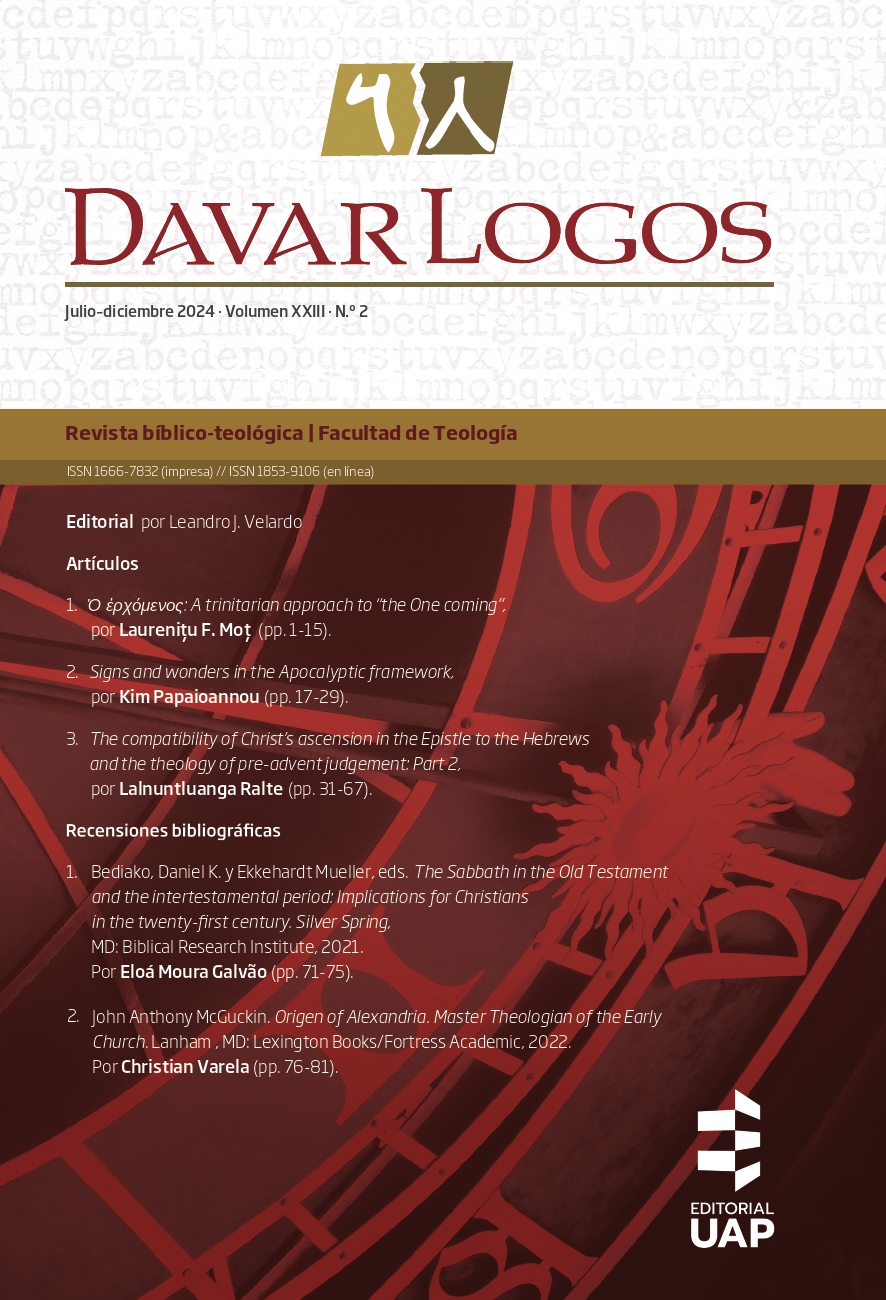Señales y prodigios en el marco apocalíptico
DOI:
https://doi.org/10.56487/dl.v23i2.1197Palabras clave:
Señales y prodigios — Milagros — Eschaton — ApocalipsisResumen
El cristianismo contemporáneo está fascinado por las supuestas manifestaciones sobrenaturales. La Biblia habla de señales y prodigios. ¿De qué manera la evidencia bíblica influye en la fascinación contemporánea? La aparición de señales y prodigios en la Biblia se centra en tres periodos fundamentales: el éxodo, la época de Jesús y los apóstoles, y el eschaton.
Mientras que en el primero son el resultado de la intervención divina, en el eschaton se asocian a las actividades de poderes antidioses. Del mismo modo, el Apocalipsis habla de señales del fin de los tiempos que serán realizadas por el falso profeta. Su propósito es engañar, si es posible, al pueblo de Dios. Este cuadro aleccionador exige vigilancia espiritual ante cualquier pretensión de manifestaciones sobrenaturales.
Descargas
Referencias
Holman Bible dictionary, s. v. “miracles, signs, wonders”, accessed on July 20, 2021, https://www.
studylight.org/dictionaries/eng/hbd/m/miracles-signs-wonders.html.
Amazon, “Signs and wonders”, accessed on November 22, 2024, https://www.amazon.com/
s?k=%22signs+and+wonders%22&crid=2HDHQFUE0EG5D&qid=1732262043&sprefix-
=signs+and+wonders+%2Caps%2C425&ref=sr_pg_1.
E.g., John A. Algera, Signs and wonders: A reformed look at the Spirit’s ongoing work (Grand
Rapids, MI: Faith Alive Christian Resources, 2015); John Wimber and Kevin Springer, Power
evangelism (Ventura, CA: Regal, 2009), especially pages 205-260.
E.g., Μαρία Σκλείδα, “Άγιοι θεραπευτές των ψυχών και των σωμάτων. Θαυμαστές ‘δυνάμεις’, ‘σημεία’,
‘τέρατα και θαυμάσια’”, accessed on November 22, 2024, https://www.pemptousia.gr/2020/04/
agii-therapeftes-ton-psichon-ke-ton-somaton-thavmastes-dinamis-simia-terata-ke-thavmasia.
E.g., Joseph Pronechen, The fruits of Fatima: A century of signs and wonders (Manchester, N.H.:
Sophia Institute Press, 2019).
English Standard Version (ESV) throughout unless otherwise noted. Exod 7,3; Deut 4,34;
,22; 7,19; 13,1,2; 26,8; 28,46; 29,3; 34,11; Neh 9,10; Ps 135,9; Jer 32,20.21; Dan 4,2.3;
,27; Matt 24,24; Mark 13,22; John 4,48; Acts 2,19.22.43; 4,30; 5,12; 6,8; 7,3; 14,3; 15,12;
Rom 15,19; 2 Cor 12,12; 2 Thess 2,9; Heb 2,4. Numbers vary slightly depending on the
translation used, but this does not change the overall picture.
Duane L. Christensen, Deuteronomy 1:1-21:9, WBC, rev. ed. (Nashville, TN: Thomas Nelson,
, 271, the sign or wonder in question “should be viewed with scepticism”.
Jesus “desired a belief characterized by dedication rather than amazement, and the second
half of the episode shows that his aim was to inculcate a genuine commitment rather
than merely to perform a cure”. Merrill C. Tenney, “John”, The expositor’s Bible commentary,
vols., ed. by Frank E. Gaebelein (Grand Rapids, MI: Zondervan, 1976-1992), 9:60.
Kenneth O. Gangel, Holman New Testament Commentary: Acts, ed. by Max Anders (Nashville,
TN: Broadman & Holman, 1998), 28.
Carson, “Matthew”, in The expositor’s Bible commentary, 503, notes that believers must not be
deceived by “spectacular signs and miracles”.
Michael J. Wilkins, The NIV Application Commentary: Matthew (Grand Rapids, MI: Zondervan,
, 781, notes that while false messiahs and false prophets would characterize “the entire
age until the Parousia”, just before the coming of Jesus “there will be an unprecedented rise
of miracle-working false messiahs and prophets”.
David J. Williams, 1 and 2 Thessalonians (Peabody, MA: Hendrickson, 1992), 129, notes that
signs and wonders together with “power” (δύναμις) also appear in Acts 2,22 of the work of Jesus.
The implication is probably that we see here is an expectation of a power that wants to impersonate
or replicate the works of Jesus.
Ibid., 129.
David E. Aune, Revelation 6-16, WBC (Nashville, TN: Thomas Nelson, 1998), 679, suggests
that the three singular uses are interconnected because 12,3 and 15,1 are introduced with the
words “another sign”. This is correct as far as the flow of the prophetic timeframe is concerned;
however, the first two singulars do not involve a direct miraculous divine intervention – indeed
in 12,3 the great sign is a red dragon, a symbol of Satan (12,9). Leon Morris, in Revelation:
An introduction and commentary, TNT vol. 20 (Downers Grove, IL: IVP Academic, 1987),
, notes that though in John semeion is used in the gospel of John of Jesus’ miracles, “here
,1] it seems to refer to a significant person rather than a significant happening” and compares
with the use 12,3 and 15,1).
In Exodus 7,14-25 (plague 1) the Nile turns to blood and this causes thirst; in Revelation
,4-9 (plagues 2 and 3) the ocean and rivers turn to blood which causes thirst. In Exodus
,1-15 (plague 2) frogs appear; in Revelation 16,12-16 unclean spirits resembling frogs deceive
the kings of the earth. In Exod 8,16-19 (plague 3) gnats appear leading Pharaoh’s magicians
to acknowledge that God is at work; in Revelation 16,9.11.21 the wicked acknowledge
that God is at work. In Exodus 9,8-12 boils appear (plague 6); in Revelation 16,2 the wicked
receive painful sores. In Exodus 9,23-25 hail and fire descend upon Egypt (plague 7); in Revelation
,17-21 great hail falls on the earth (plague 7). In Exodus 10,21-29 a heavy darkness
fell upon Egypt (plague 9); in Revelation 16,10-11 a great darkness that causes pain falls on
the wicked (plague 5).
Cf. Jack Hillard, Understanding Revelation (Longwood, FL: Xulon, 2008), 139: “… in some respects
the seven last plagues were similar to the ten plagues God brough on Egypt (Exodus 5:1-
:30)”. Aune, Revelation 6-16, 869-70, sees a connection to the “plagues” of the seven seals and
seven trumpets prophecies though admits that the word “plague” is not used in either.
Aune, Revelation 6-16, 758-59.
Morris, Revelation, 166.
Ian Paul, Revelation: An introduction and commentary, TNTC 20 (Downers Grove, IL: IVP Academic,
, 237, explains that talking images with the following words: “… the development
of automata and the use of ventriloquism in the ancient world as part of pagan religion and in
particular as part of the imperial cult”. Obviously, much more is at stake in this end-time image,
that go beyond mere deceptive tricks.
Aune, Revelation 6-16, 759, points to the ministry of Elijah, namely the fire that came down
from heaven (1 Kgs 18,38) and the fire that consumed the soldiers who came to arrest him
(2 Kgs 1,10) which he compares with the request of James and John for fire to come down on
the Samaritans (Luke 9,54). Other instances can also be invoked (e.g., Aune, Revelation 6-16,
, especially the fire that consumed David’s sacrifice (1 Chr 21,26), the sacrifices at the inauguration
of the temple (2 Chr 8,1), and the fires that devoured Nadab and Abihu (Lev 10,1-2),
and Sodom and Gomorrah (Gen 19,24). Perhaps even the first that fell upon Egypt together
with hailstone (Exod 9,23). In Job 1,16 the fire that destroyed Job’s sheep is described as “the fire
of God” though reading the statement in the context of the two heavenly councils ( Job 1,6-12;
Job 2,1-7) it seems that Satan is the active agent in the catastrophes that fall upon Job.
Ranko Stefanovic, Revelation of Jesus Christ, 2nd ed. (Berrien Springs, MI: Andrews University
Press, 2002), 369-371.
Ibid., 371.
See e.g., Morris, Revelation, 166,
Aune, Revelation 6-16, 760.
ESV/KJV/NKJ/YLT, “three unclean spirits like frogs;” RSV/NRS “three foul spirits like
frogs;” NIV, “three evil spirits that looked like frogs”. The English translations, even the YLT,
miss the force of the original. The Greek πνεύματα τρία ἀκάθαρτα ὡς βάτραχοι should more accurately
be translated as “three spirits unclean like frogs”. The Greek can mean either that the
unclean spirits look like frogs (if we assume a comma after “unclean”), or that they are as unclean
as frogs are (if we assume a comma before “unclean”). The second nuance is more likely since unclean
spirits do not appear in the Bible in the shape of animals, but they are compared to unclean
animals (e.g., Rev 18,2) in their uncleanliness. It is possible that both nuances are in view.
Morris, Revelation, 236; Stefanovic, Revelation of Jesus Christ, 371; Aune, Revelation 6-16, 760.
Carson, “Matthew”, in The expositor’s Bible commentary, 503.
Descargas
Publicado
Número
Sección
Licencia
Derechos de autor 2025 DavarLogos

Esta obra está bajo una licencia internacional Creative Commons Atribución-NoComercial-CompartirIgual 4.0.





